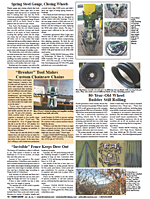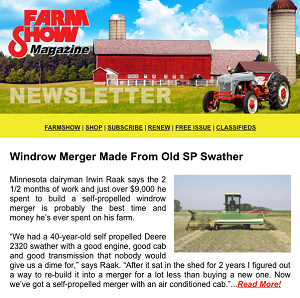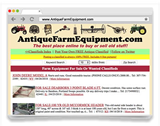Commerical System Turns Waste Oil Into Fuel
Why buy diesel fuel if you can use your waste oil in the tank? MyBioFuelBuddy can be used on waste petroleum fluids and vegetable oils, fresh or used. The filtration system removes metal particles, water, antifreeze, glycerin and other contaminants. Marvin Neufeld developed the filtration system to be portable so he could take it along when he is custom combining. He and his son Deric now offer key components and a building plan for do-it-yourselfers.
"I've run waste engine oil through my filtration system and used it in two Detroit Series 60 diesel engines in Volvo semis," says Neufeld. "The waste oil/diesel mix cleared up a knocking problem the engines had. They have never run as smoothly as they do now."
Neufeld credits the extra lubrication for clearing up the knocking. He says the filtered oil also has more BTU value than diesel fuel, and the engines generate more horsepower.
He recommends starting off with a 10% oil blend and gradually adding higher levels of filtered oil to diesel fuel. Most engines, he says, can handle a 50-50 blend, though some can go higher.
The main components in the system are mesh screens, three magnets and a set of four mesh tubes in the bottom of the tank. Neufeld first runs used oil through a separator tank, where most water and heavy sludge are removed. Then he pumps it through a 149-micron suction strainer with replaceable filter. It then runs across the magnets and through a one-micron filter and into the tank, where material in the tubes attract and solidify liquid contaminants.
"Each of the four tubes has about half a pound of material that absorbs the water, paraffin, antifreeze, etc. from the oil," explains Neufeld. "A teaspoon of the material will turn a cup of water into Jell-O."
He adds that as the material in the tubes is activated to hold the non-oil liquids, the tubes begin to fill. When the ends bulge out of the tubes, it's time to replace them.
While the system can be used to filter glycerin and water out of vegetable oils, Neufeld notes that vegetable oil, new or used, doesn't have the BTU qualities of waste engine oil. He adds that it also quickly uses up the filtration medium in the tubes.
The kit with the five-stage filtration system components includes a 30-page building plan as well as more than 65 pictures to illustrate the building process.
Neufeld says the system can also be used as a transfer pump. Building plans with the basic filtration system are priced at $499.95. Other components are available separately. A complete kit with all parts and instructions is available for $1,495.
Contact: FARM SHOW Followup, DJN Direct, P.O. Box 322, Havre, Montana 59501 (ph 406 265-5715; toll free 888 260-9079; support@mybiofuelbuddy.com; www.mybiofuelbuddy.comBuild_Plans_Kit. html).

Click here to download page story appeared in.
Click here to read entire issue
Commerical System Turns Waste Oil Into Fuel ENERGY Waste Oil 32-4-3 Why buy diesel fuel if you can use your waste oil in the tank? MyBioFuelBuddy can be used on waste petroleum fluids and vegetable oils, fresh or used. The filtration system removes metal particles, water, antifreeze, glycerin and other contaminants. Marvin Neufeld developed the filtration system to be portable so he could take it along when he is custom combining. He and his son Deric now offer key components and a building plan for do-it-yourselfers.
"I've run waste engine oil through my filtration system and used it in two Detroit Series 60 diesel engines in Volvo semis," says Neufeld. "The waste oil/diesel mix cleared up a knocking problem the engines had. They have never run as smoothly as they do now."
Neufeld credits the extra lubrication for clearing up the knocking. He says the filtered oil also has more BTU value than diesel fuel, and the engines generate more horsepower.
He recommends starting off with a 10% oil blend and gradually adding higher levels of filtered oil to diesel fuel. Most engines, he says, can handle a 50-50 blend, though some can go higher.
The main components in the system are mesh screens, three magnets and a set of four mesh tubes in the bottom of the tank. Neufeld first runs used oil through a separator tank, where most water and heavy sludge are removed. Then he pumps it through a 149-micron suction strainer with replaceable filter. It then runs across the magnets and through a one-micron filter and into the tank, where material in the tubes attract and solidify liquid contaminants.
"Each of the four tubes has about half a pound of material that absorbs the water, paraffin, antifreeze, etc. from the oil," explains Neufeld. "A teaspoon of the material will turn a cup of water into Jell-O."
He adds that as the material in the tubes is activated to hold the non-oil liquids, the tubes begin to fill. When the ends bulge out of the tubes, it ęs time to replace them.
While the system can be used to filter glycerin and water out of vegetable oils, Neufeld notes that vegetable oil, new or used, doesn't have the BTU qualities of waste engine oil. He adds that it also quickly uses up the filtration medium in the tubes.
The kit with the five-stage filtration system components includes a 30-page building plan as well as more than 65 pictures to illustrate the building process.
Neufeld says the system can also be used as a transfer pump. Building plans with the basic filtration system are priced at $499.95. Other components are available separately. A complete kit with all parts and instructions is available for $1,495.
Contact: FARM SHOW Followup, DJN Direct, P.O. Box 322, Havre, Montana 59501 (ph 406 265-5715; toll free 888 260-9079; support@ mybiofuelbuddy.com; www.mybiofuelbuddy. comBuild_Plans_Kit. html).
To read the rest of this story, download this issue below or click
here to register with your account number.








